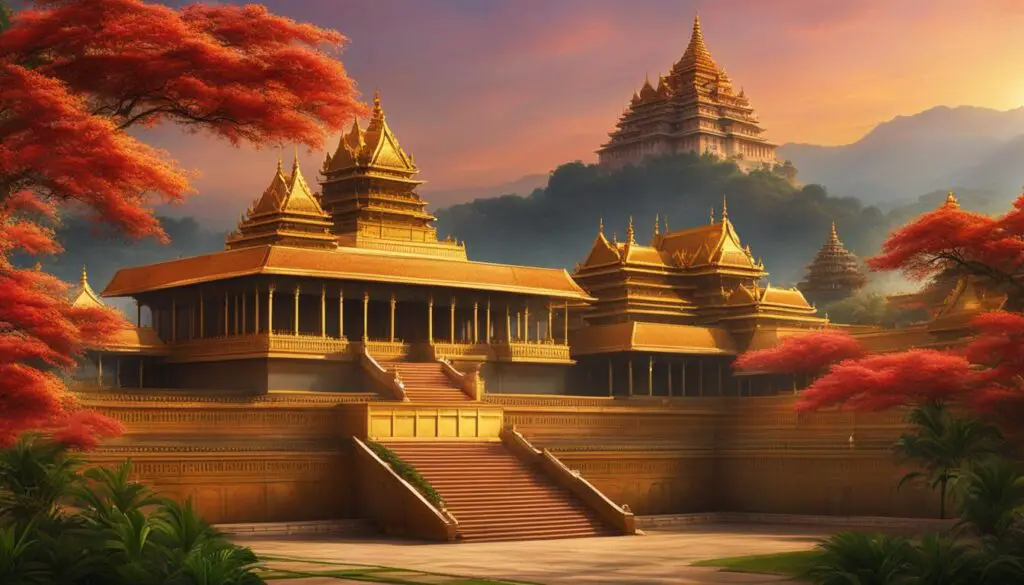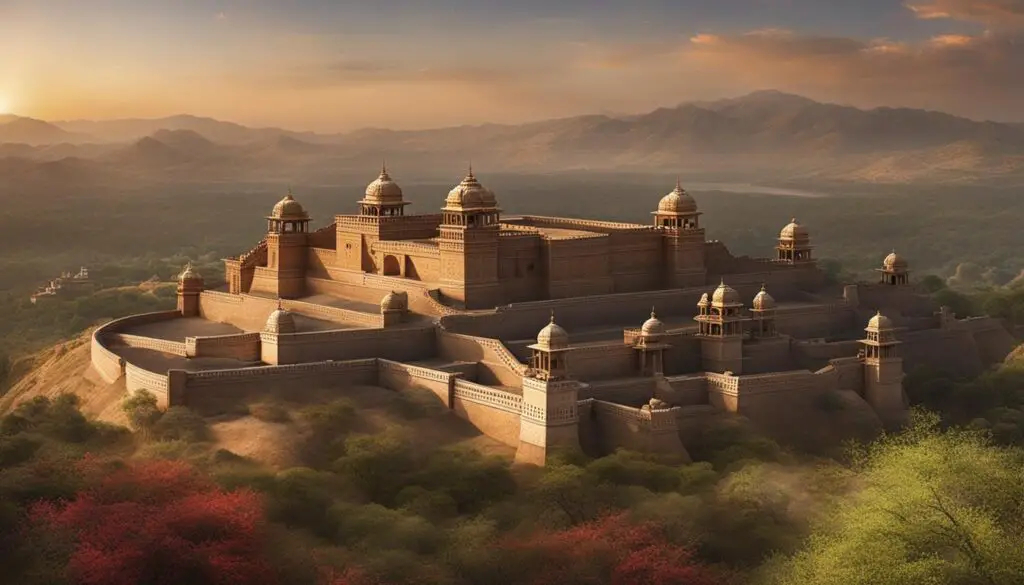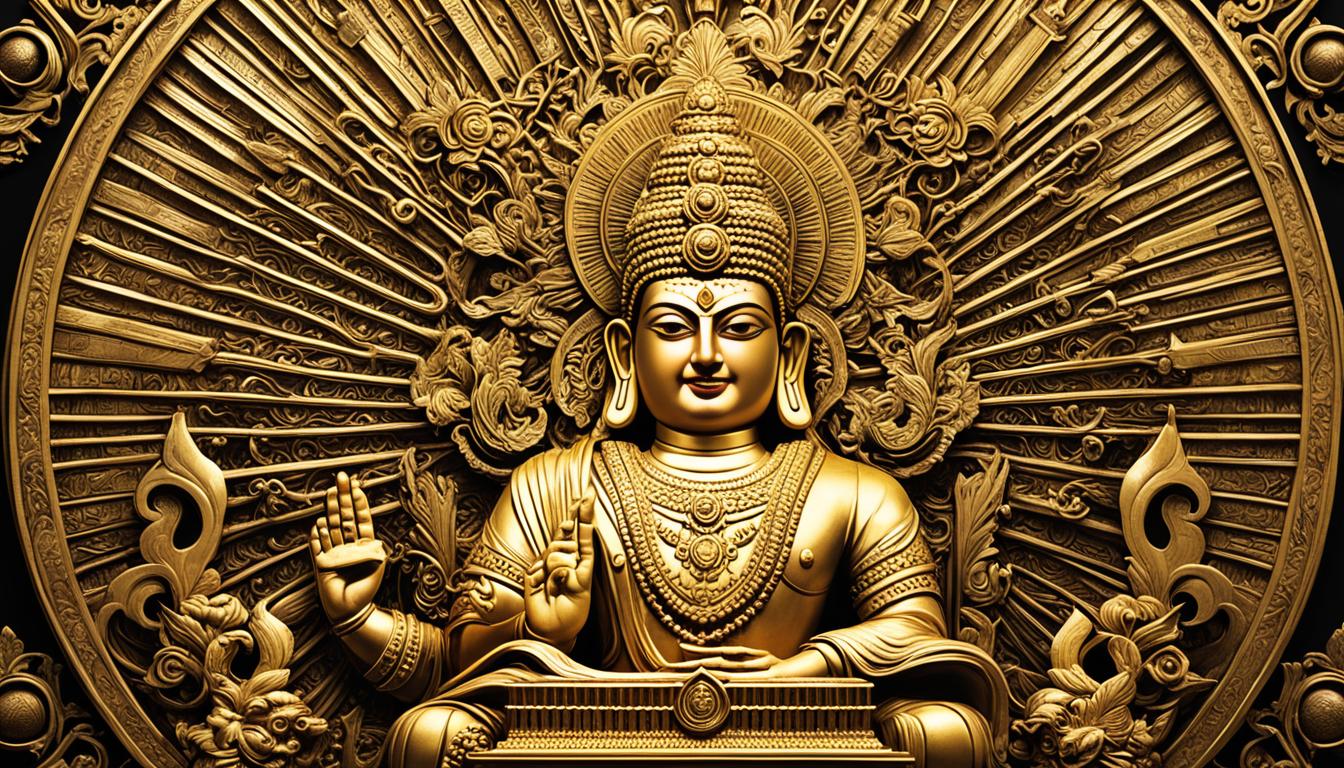Have you ever wondered about the impact one ruler can have on the history and culture of a region? Meet Nagabhata I, the ancient ruler who founded the Gurjara-Pratihara dynasty in the mid-8th century CE. His legacy continues to shape the northwestern region of the Indian subcontinent, leaving behind a rich tapestry of history and cultural influences.
Key Takeaways:
- Nagabhata I founded the Gurjara-Pratihara dynasty in the 8th century CE.
- The dynasty had a prominent impact on the history and culture of the northwestern region of the Indian subcontinent.
- Under the Gurjara-Pratiharas, the region witnessed military conquests and a flourishing of arts and architecture.
- The decline of the Gurjara-Pratihara dynasty paved the way for the rise of the Rajput kingdoms in Rajasthan.
- The legacy of the Gurjara-Pratiharas continues to be an integral part of India’s rich historical heritage.
The Gurjara-Pratihara Dynasty: Origins and Rise
The Gurjara-Pratihara dynasty, also known as the Pratihara Empire, emerged in the 6th century CE in present-day Rajasthan and Gujarat. The dynasty’s early origins are associated with the Gurjar community, known for their warrior traditions and agricultural pursuits. The Gurjara-Pratiharas initially established their power base in Rajasthan and Gujarat, utilizing their military prowess and strategic acumen to expand their dominion.
Through military conquests and matrimonial alliances, the Gurjara-Pratiharas gradually extended their influence over the Rajputana region, encompassing areas such as Marwar. Rajasthan, with its diverse landscapes and rich cultural tapestry, became an important sphere of influence for the dynasty.
The capital of the Gurjara-Pratiharas was Mandore, near Jodhpur, which served as the center of power from where they administered their rule over Rajasthan. Their control over the region resulted in a flourishing of literature, sculpture, and temple architecture, with the dynasty actively promoting the arts and culture.
One of the most significant periods in the Gurjara-Pratihara dynasty was during the reign of King Bhoja, from 836-885 CE. Under his rule, the dynasty expanded its influence into central and northern India, contributing significantly to the realm of Sanskrit literature and the promotion of learning.
“The Gurjara-Pratiharas established their power base in Rajasthan and Gujarat, strategically expanding their dominion through military conquests and matrimonial alliances. Their rule extended to significant territories, and they actively promoted art, architecture, and literature.”
Notable Achievements of the Gurjara-Pratiharas during their Rise
- Expansion of dominion through military conquests and strategic alliances
- Establishment of cultural and artistic patronage
- Flourishing of literature, sculpture, and temple architecture
- Promotion of Sanskrit literature and learning during the reign of King Bhoja

As the Gurjara-Pratiharas grew in power and influence, their legacy began to take shape, leaving a lasting impact on the history and culture of the region. However, challenges and conflicts loomed on the horizon, leading to the decline of the dynasty, which will be explored in the next section.
Challenges and Decline of the Gurjara-Pratiharas
Despite their earlier successes, the Gurjara-Pratiharas faced numerous challenges that eventually led to their decline. Internal power struggles, external invasions, and shifting alliances with other regional powers weakened their empire.
The Chahamana (Chauhan) dynasty, along with other rival kingdoms, began to challenge the Gurjara-Pratiharas’ authority in Rajasthan and adjacent territories. The political landscape of North India evolved rapidly during this period, with the Gurjara-Pratiharas gradually losing their grip on the region. The rise of other powers, such as the Ghaznavids and the Rajputs, further eroded their authority.
“The decline of the Gurjara-Pratiharas marked the end of their reign in Rajasthan and the ascendancy of the Rajput kingdoms.”
However, their legacy lives on through their contributions to architecture, sculpture, and the cultural heritage of the region. The Gurjara-Pratiharas’ historical significance in Rajasthan, both in terms of their ascendancy and decline, continues to shape the narrative of this vibrant land.

Conclusion
The Gurjara-Pratihara dynasty has left an indelible mark on the history and culture of Rajasthan. Rising to power in the 6th century CE, this powerful empire held its capital in Mandore and extended its rule over the region, including territories like Marwar. The Gurjara-Pratiharas were not only accomplished warriors but also avid patrons of literature, sculpture, and temple architecture.
During the reign of King Bhoja, the Gurjara-Pratiharas reached their zenith, fostering a period of cultural and intellectual pursuits. However, internal conflicts and external invasions in the following years weakened their empire, ultimately leading to their decline. The rise of rival kingdoms, especially the Rajputs, brought an end to their authority in Rajasthan.
Nevertheless, the legacy of the Gurjara-Pratiharas lives on through their cultural and architectural contributions. Their influence on Rajasthan’s history and heritage cannot be understated. The rich tapestry of literature, impressive sculptures, and magnificent temples that they left behind serve as a testament to their historical significance.
The Gurjara-Pratiharas continue to shape the identity of Rajasthan, with their legacy deeply ingrained in the region’s cultural fabric. Exploring their achievements, rise, and decline helps us better understand the historical journey of this vibrant land, while also highlighting the enduring legacy of the Gurjara-Pratihara dynasty.
FAQ
Who was Nagabhata?
Nagabhata I was the founder of the Gurjara-Pratihara dynasty in the mid-8th century CE. He played a significant role in the history of Rajasthan and the Indian subcontinent.
What is the Gurjara-Pratihara dynasty?
The Gurjara-Pratihara dynasty, also known as the Pratihara Empire, was a powerful empire that emerged in the 6th century CE in present-day Rajasthan and Gujarat. They expanded their dominion through military conquests and matrimonial alliances.
Where was the capital of the Gurjara-Pratiharas?
The capital of the Gurjara-Pratiharas was located in Mandore, near Jodhpur in Rajasthan. It served as the center of power from which they administered their rule over the region.
What was the cultural impact of the Gurjara-Pratiharas?
The Gurjara-Pratiharas were patrons of the arts and culture. During their reign, there was a flourishing of literature, sculpture, and temple architecture. Their legacy is still evident in the northwestern region of India.
What led to the decline of the Gurjara-Pratiharas?
The decline of the Gurjara-Pratiharas was influenced by internal conflicts, external invasions, and shifting power dynamics with other regional powers. The rise of rival kingdoms, such as the Rajputs, further weakened their empire.
What is the historical significance of the Gurjara-Pratiharas?
The Gurjara-Pratiharas have left a lasting impact on the history and culture of Rajasthan. Their contributions to architecture, sculpture, and literature continue to shape the identity and heritage of the region.
Source Links
- https://www.ijfmr.com/papers/2023/6/9513.pdf
- https://edurev.in/question/533811/Who-is-nagabhatta-
- https://vocal.media/fyi/gurjara-pratihara-dynasty

